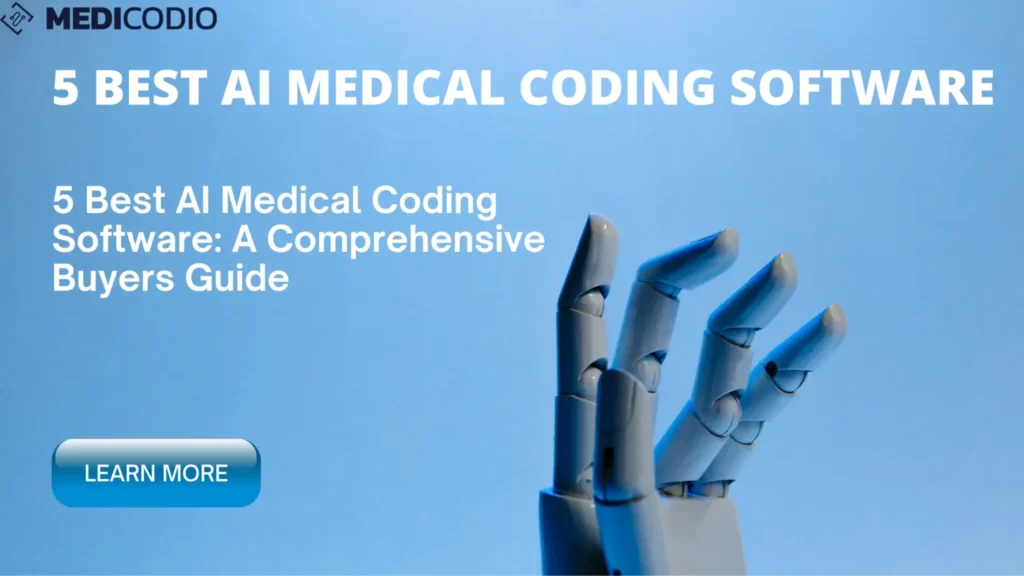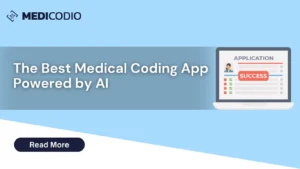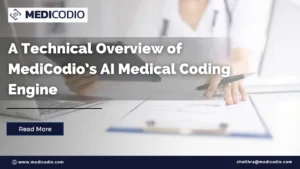Table of Contents
Are you curious about AI Medical Coding Software? Relax! We’ll walk you through the ins and outs of the AI tool.
In today’s healthcare industry, medical coding plays a crucial role in accurately documenting and categorizing patient diagnoses, procedures, and treatments. Medical coders are responsible for ensuring that healthcare providers are appropriately reimbursed for their services. By thoroughly verifying patient documents and assigning appropriate codes, medical coders help in reimbursement and research, and analysis and facilitate effective communication among healthcare professionals. However, the process of medical coding can be complex, time-consuming, and prone to errors. According to an estimate from the American Medical Association (AMA), the healthcare industry loses around $36 billion each year due to coding errors. These errors result in lost revenue, denied claims, and potential fines.
To overcome these challenges, the integration of artificial intelligence (AI) in medical coding software has become increasingly necessary.
What is the AI tool for medical coding?
AI-powered medical coding software combines the capabilities of machine learning algorithms, natural language processing (NLP), and advanced data analytics to automate and streamline the coding process. This technology has the potential to revolutionize medical coding by improving accuracy, efficiency, and productivity.
One of the primary reasons healthcare and RCM companies need AI medical coding software is because of the vast amount of healthcare data generated daily. With the digitalization of medical records and the implementation of electronic health records (EHRs), healthcare organizations are grappling with enormous amounts of patient data. AI algorithms can quickly analyze and interpret this data, extracting relevant information and assigning appropriate codes. This significantly reduces the burden on human coders, who would otherwise have to manually review and assign codes to each medical record.
Moreover, AI medical coding software can continuously learn and adapt. By training on large datasets and incorporating feedback from human coders, these systems can improve their accuracy over time. They can recognize patterns, identify trends, and make connections between different medical concepts, leading to more accurate and consistent coding.
Another important aspect is the reduction of coding errors. Manual coding is prone to human errors, such as misinterpretation of medical documentation or incorrect code assignment. These errors can have significant consequences, including billing discrepancies, claim denials, and compliance issues. AI medical coding software, with its advanced algorithms, can minimize such errors by leveraging extensive medical knowledge and guidelines. It can cross-reference patient data with coding guidelines and regulations, ensuring compliance and reducing the risk of coding mistakes.
Furthermore, AI medical coding software can greatly enhance productivity and efficiency in healthcare organizations. Automating the coding process frees up valuable time for human coders to focus on more complex cases or handle other critical tasks. This improves overall workflow and allows healthcare providers to deliver timely and accurate healthcare services to their patients.
All in all, the need for AI medical coding tools is driven by the growing complexity of healthcare data, the demand for accuracy and consistency in coding, and the desire to optimize efficiency and productivity. By harnessing the power of AI, healthcare organizations can streamline their coding processes, minimize errors, and ensure accurate reimbursement for services rendered. AI medical coding software is poised to revolutionize the field of medical coding, empowering healthcare professionals to deliver better patient care in a rapidly evolving healthcare landscape.
Who can use AI Medical Coding Software?
Healthcare facilities and RCM companies find AI medical coding software to be a highly robust tool for streamlining and improving all aspects of their medical coding activities. Below mentioned are some of the organizations that find this software highly useful. Let’s take a look at them!
Healthcare facilities and RCM companies can utilize AI medical coding software in several ways to enhance their coding processes and improve overall efficiency. One of the major challenges that these organizations face is finding skilled coders specializing in all specialties. Recruiting such skilled people is not only difficult but it is expensive too. And to get reimbursement quickly, the medical coding team should process patient documents quickly without any errors. This is where AI medical coding software proves to be invaluable.
Why Should You Use an AI Medical Coding Tool?
How does AI affect medical coding? AI Medical Coding tools have emerged as a transformative force, streamlining all medical coding-related tasks. Some of the reasons why one should get their hands on AI Medical Coding software include.
-
- Automated Medical Coding: AI medical coding system automates the analysis of patient records, extracting information, and assigning codes, reducing manual coding time and effort.
-
- Improved Accuracy: AI algorithms interpret complex medical documentation accurately, ensuring consistent and precise code assignment, and reducing billing discrepancies and claim denials.
-
- Improved Productivity: According to a survey, coders with five or more years of experience coded an average of 27.6 charts per day, while coders with less than one year of experience coded an average of 12.2 charts per day. With AI medical coding tools, medical coders can double their productivity.
-
- Compliance and Regulation: AI medical coding software cross-references patient data with coding guidelines, regulations, and payer requirements, ensuring compliance and avoiding penalties.
-
- Real-Time Feedback and Education: AI medical coding assistant provides feedback to coders, flagging errors and offering suggestions for prompt correction, improving coding accuracy, and acting as an educational tool.
-
- Continuous Learning and Improvement: AI coding software learns from feedback, refining algorithms, recognizing patterns, and adapting to changes in medical practices and coding guidelines.
-
- Workflow Optimization: AI software automates routine coding tasks, freeing up human coders to focus on complex cases, enhancing workflow efficiency, and handling higher volumes of coding tasks.
-
- Data Analytics and Insights: AI coding software analyzes healthcare data, identifying trends, patterns, and correlations, enabling informed decision-making on resource allocation, quality improvement, and revenue optimization.
Features of AI Medical Coding Software
Being a highly robust tool, campaign management software helps organizations improve their marketing campaigns and make their processes more efficient. Some of the most common features of campaign management software include:
Reads Data From various EHRs: AI medical coding software is the ability to read data from various Electronic Health Record (EHR) systems. By being compatible with multiple EHR systems, the AI coding software can seamlessly integrate with the existing infrastructure of healthcare facilities. This allows for efficient data retrieval, eliminating the need for manual data entry or complex data conversion processes. The software utilizes advanced algorithms and techniques such as Natural Language Processing (NLP) to analyze and interpret the data extracted from EHRs.
Medical Code Prediction for All Specialties: AI medical coding software predicts medical codes for all specialties. It employs machine learning algorithms and extensive medical knowledge to accurately anticipate the appropriate codes for various medical procedures, diagnoses, and treatments across different medical specialties. This capability streamlines the coding process, enhances efficiency, and ensures consistent and accurate coding across all healthcare specialties.
CPT/ICD Search Function: Another important feature of AI medical coding software is the CPT/ICD search function. This function allows users to search for specific Current Procedural Terminology (CPT) codes or International Classification of Diseases (ICD) codes within the software. Users can input relevant keywords, medical terms, or descriptions to quickly locate the appropriate codes. This search function simplifies the coding process, saves time, and helps ensure accurate code selection for various medical procedures and diagnoses.
NCCI Edits Check: AI medical coding software includes an NCCI (National Correct Coding Initiative) edit check feature. This feature helps ensure compliance with NCCI guidelines, which identify code combinations that should not be reported together for the same patient encounter. The software automatically checks for any potential NCCI edits or conflicts between codes, flagging them for review and correction. This functionality helps healthcare facilities maintain accurate and compliant coding practices, reducing the risk of coding errors and potential billing discrepancies.
Claim Charge Capture reporting: Claim charge capture reporting is a crucial feature of AI medical coding software. It enables healthcare facilities to accurately capture and report all billable services and procedures provided to patients. The software tracks and records detailed information such as procedures performed, medication administration, tests conducted, and other relevant chargeable items. This functionality ensures comprehensive and accurate documentation for billing and reimbursement, minimizing revenue loss and maximizing revenue capture for healthcare providers.
Detailed Dashboards: AI medical coding software offers detailed dashboards as a valuable feature. These dashboards provide users with visual and comprehensive overviews of coding activities, metrics, and performance indicators. Users can access real-time data and analytics, such as coding volumes, coding accuracy rates, productivity metrics, and coding trends. Detailed dashboards empower healthcare facilities to monitor and track coding processes effectively, make informed decisions, identify areas for improvement, and optimize coding workflows for enhanced efficiency and productivity.
Automatic Data entry: Automatic data entry eliminates the need for manual data entry by automatically populating relevant information from patient records into the coding system. The software extracts data from various sources, such as electronic health records (EHRs) or scanned documents, and transfers it directly to the coding interface. This automation reduces the time and effort required for data entry, minimizes the risk of human error, and streamlines the coding process, enabling healthcare professionals to focus on other critical tasks.
Faster Turnaround Time: AI medical coding software provides a significant advantage in terms of faster turnaround time. By leveraging automation and advanced algorithms, the software accelerates the coding process, allowing healthcare facilities to process a higher volume of records in less time. It eliminates manual tasks, reduces coding errors, and streamlines workflows, resulting in quicker coding turnaround times. This improved efficiency ultimately benefits healthcare facilities by enabling prompt billing, faster claim submission, and quicker reimbursement, contributing to enhanced revenue cycle management and overall operational effectiveness.
Benefits of AI Medical Coding Assistant
What are the benefits of AI in medical coding?
-
- Reduce costs: Every year healthcare organizations lose millions of dollars due to common coding and claim processing errors. AI-powered CODIO can help medical coders avoid mistakes during coding and save a significant amount of capital. They can also help to reduce administrative costs for healthcare organizations, as they can automate the coding process and eliminate the need for manual data entry.
-
- Improve Accuracy: The automated medical coding tool can collect data and choose codes accurately in less time which will help healthcare providers to improve efficiency by up to 45%.
-
- Comply with coding regulations: Medical coding is known to undergo frequent guideline and mandate changes. CODIO allows medical coders to be well-versed in both traditional and new coding regulations to ensure their codes adhere to all the necessary guidelines. It will cut down on regular training costs.
-
- Develop a flawless submission process: The best medical coding software always ensures to review all documents before submission. CODIO eliminates time-consuming and costly processes of resubmission and appeals by thoroughly reviewing documents.
-
- Easy to use: CODIO can be used by anyone with a little technical knowledge. It requires minimal training for medical coders.
-
- Seamless Integration: Customize your workflows to fit specific payer contracts and EMR/Clearinghouse systems by integrating them with any EHR or billing system.
-
- Save time: Reduce coding turnaround time while increasing code accuracy and preventing downcoding.
How to Choose the Right AI Medical Coding Software?
Choosing the right AI medical coding software requires careful consideration and evaluation of several key factors. Here are some essential steps to help you in selecting the most suitable AI medical coding software for your needs:
-
- Identify Your Requirements: Start by clearly defining your specific requirements and objectives. Determine the scope of your coding needs, the volume of records to be processed, and any unique coding challenges or specialized coding requirements you may have.
- Evaluate Accuracy and Performance: Assess the accuracy and performance of the AI medical coding software. Look for evidence of its ability to accurately interpret medical documentation, assign appropriate codes, and consistently achieve high coding accuracy rates. Consider performance metrics, such as processing speed and scalability, to ensure the software can handle your coding volume effectively.
- Compliance and Regulations: Verify that the AI coding software adheres to coding guidelines, regulations, and payer requirements. It should have the capability to cross-reference patient data with industry standards, coding regulations, and compliance guidelines to ensure accurate and compliant coding practices.
- Integration and Interoperability: Consider the software’s compatibility and integration capabilities with your existing systems, such as electronic health records (EHRs) or practice management software. Seamless integration and interoperability will facilitate data exchange and streamline coding workflows.
- User Interface and Ease of Use: Evaluate the user interface and user experience of the AI medical coding software. It should have an intuitive interface, easy navigation, and user-friendly features that simplify the coding process and minimize the learning curve for coders.
- Training and Support: Inquire about the training and support provided by the software vendor. Determine if they offer comprehensive training materials, user manuals, online resources, and responsive customer support to assist with any technical issues or questions that may arise.
- Security and Privacy: Ensure that the AI medical coding software adheres to strict security and privacy protocols to protect patient data. It should comply with relevant regulations, such as HIPAA (Health Insurance Portability and Accountability Act), and employ robust data encryption and access controls.
- Scalability and Future Readiness: Consider the scalability of the AI coding software to accommodate future growth and evolving coding needs. Verify if the software can adapt to changing coding guidelines and industry requirements, ensuring long-term viability.
- Cost and Return on Investment (ROI): Evaluate the pricing structure and total cost of ownership for the AI medical coding software. Consider the potential ROI in terms of increased coding efficiency, accuracy, reduced errors, and improved revenue cycle management.
- Vendor Reputation and References: Research the reputation and track record of the software vendor. Seek references or customer testimonials to gain insights into their performance, customer satisfaction, and reliability.
- By carefully considering these factors and conducting thorough evaluations, you can make an informed decision and choose the right AI medical coding software that aligns with your specific requirements, enhances coding processes, and supports efficient and accurate coding practices in your healthcare facility.
Latest Trends in AI Coding Software
AI medical coding software continues to evolve, incorporating the latest trends to enhance coding processes and optimize healthcare operations. Here are some of the latest trends in AI medical coding software:
-
- Natural Language Processing (NLP): AI medical coding tool is leveraging NLP techniques to analyze unstructured medical data, such as clinical notes and narratives. By understanding the context and extracting relevant information, NLP improves coding accuracy and efficiency.
- Deep Learning and Neural Networks: The AI medical coding system employs deep learning algorithms and neural networks to improve coding accuracy through pattern recognition and complex data analysis. These techniques enable the software to learn from large datasets and make more precise coding predictions.
- Explainable AI: As AI coding assistant becomes more sophisticated, there is a growing emphasis on explainability. Efforts are being made to develop AI models that can provide transparent explanations for coding decisions, enhancing trust and facilitating human oversight.
- Real-Time Coding Assistance: AI coding software is incorporating real-time feedback and assistance features to support coders during the coding process. It flags potential errors, offers suggestions, and provides coding guidelines and references, enabling coders to make more accurate and consistent coding decisions.
- Integration with EHR Systems: Seamless integration with Electronic Health Record (EHR) systems is a prominent trend. AI medical coding system is designed to work in harmony with existing EHR platforms, allowing for efficient data retrieval, automated coding, and streamlined workflows.
- Predictive Analytics: AI-powered coding software is leveraging predictive analytics to identify patterns and trends in coded data. This enables healthcare facilities to gain valuable insights for resource allocation, revenue optimization, and quality improvement initiatives.
- Remote and Cloud-Based Solutions: With the increasing adoption of remote work and cloud-based systems, AI coding software is being developed to operate effectively in these environments. This allows for flexible access, collaboration, and scalability, even when coders are working from remote locations.
- Continuous Learning and Adaptation: AI coding software is designed to continuously learn and adapt to changing coding guidelines and industry practices. By processing vast amounts of data and receiving feedback from coders, the software can refine its algorithms, improve accuracy, and stay up-to-date with evolving coding requirements.
These trends reflect the ongoing advancements in AI medical coding software, aiming to optimize coding processes, improve accuracy, and enhance overall operational efficiency in healthcare facilities.
What is the future of medical coding in India?
As India’s healthcare industry continues to grow, the demand for skilled medical coders is on the rise. With an increasing number of healthcare facilities and a focus on standardized coding systems, the future of medical coding in India looks promising.
Here’s what you need to know:
-
- Rising demand: The expanding healthcare sector requires accurate documentation and reimbursement processes.
-
- Implementation of standards: International coding systems like ICD and CPT are being adopted in India, aligning practices globally.
-
- Career opportunities: Medical coding offers a rewarding career path with room for growth and continuous learning.
5 Best AI Medical Coding Software
Here is a list of the best AI medical coding tools:
Several companies are offering AI-enabled medical coding software such as MEDICODIO, Clinion, PCG Software, Fathom, and Aideo Technologies.
MEDICODIO: As a promising AI-powered medical coding solution provider, MediCodio is committed to empowering healthcare facilities and RCM companies to augment the medical coding process. The goal is to expedite the code selection process while lowering costs, turnaround times, claim denials, and errors associated with medical coding procedures.
Types of Solutions offered by MEDICODIO.
MEDICODIO offers a Software as a Service (SaaS) tool built to streamline your medical coding workflow. The company uses a subscription-based pricing strategy that allows clients to access the software, by paying a monthly or yearly charge.
As a part of their solution, MEDICODIO also offers Medical Coding as a Service. Medical Coding as a Service (MCaaS) is a comprehensive outsourcing solution that simplifies the medical coding process for healthcare organizations. By utilizing MCaaS, our team of experienced Medical Coders will handle the coding tasks, allowing your staff to dedicate their attention to other important aspects of patient care.





